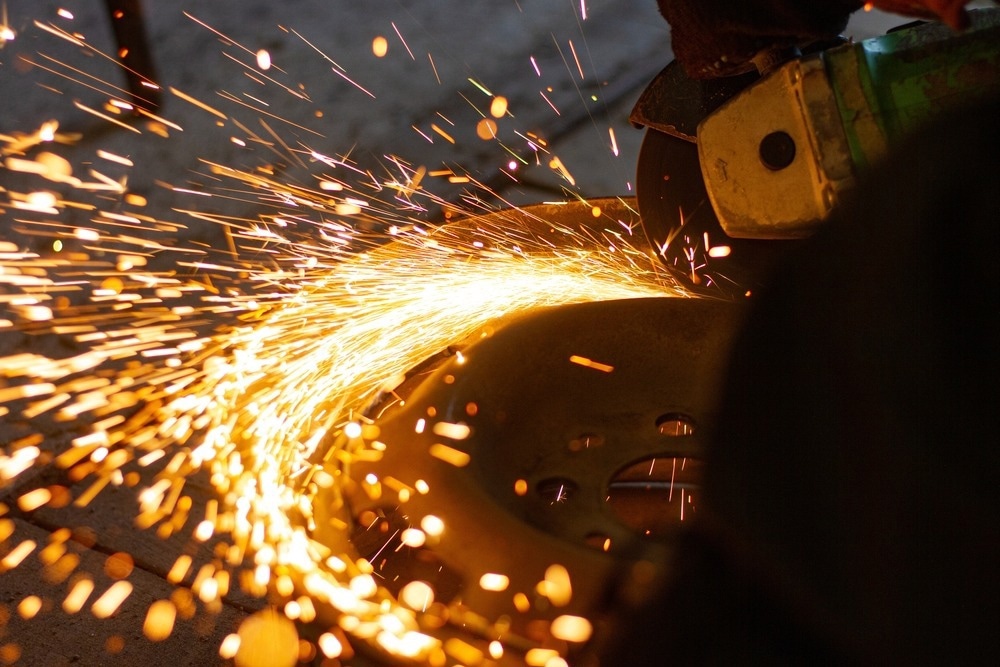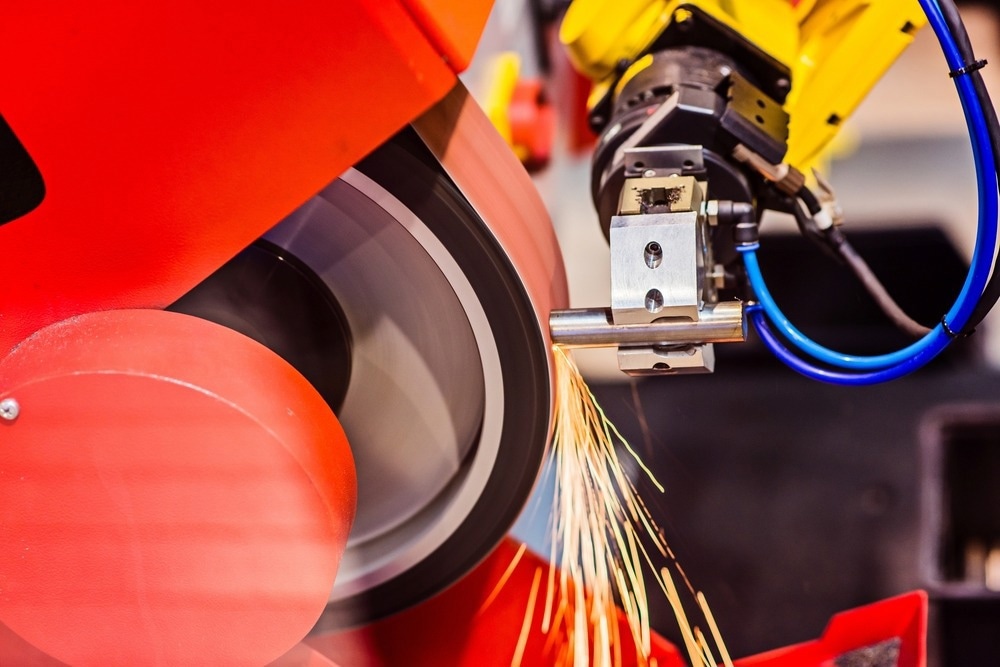Robots are increasingly being employed in nearly every sector of industry. Often, robots replace human operators in a score of tasks that may be potentially dangerous or can benefit from automated systems. This article will briefly examine the use of grinding robots in industrial material preparation.

Image Credit: LostPhoto92/Shutterstock.com
Important of Grinding and Sanding for Material Preparation
Preparing various materials, such as ceramics and metals, requires specific and high-performance manufacturing methods. The first step in any mechanical material removal is grinding, which removes deformed and damaged surface materials while ensuring that any additional surface deformation is minimized.
Material is removed by grinding processes using abrasive particles, which chip the specimen material. Such an approach ensures the highest removal rate while retaining the lowest amount of specimen material deformation.
In grinding, there are two main processes: plane grinding and fine grinding. The first step is plane grinding, which ensures similar specimen surfaces despite previous treatments and initial conditions. Specimens are placed in equipment that ensures that they are all in the same plane before fine grinding occurs to ensure consistency.
Short grinding times are used in plane grinding, and relatively large grain sizes are preferred. The next step, fine grinding, produces a relatively deformation-free surface that is suitable for finishing and polishing processes.
Materials such as diamonds are generally applied during fine-grinding processes as they guarantee uniform material removal. Proper grinding techniques ensure that polishing can be carried out in a short time.
Sanding is used to prepare smooth, defect-free, and uniform products from materials such as wood and metal, either in initial production or during restoration products. Sanding can be used to remove paint and varnish from furniture and rust from metal objects, enhancing their aesthetic appeal. Sanding can be performed by hand or with a sanding machine depending on the object’s size.
How are Robots Used for This Application?
Like many other critical industrial processes, robots are increasingly finding applications in industrial grinding and sanding. Robots are used for preparing multiple products, such as stainless-steel kitchen equipment, steel frames, pipes, aluminum chairs, automobile bumpers, and many other applications.
Automated robotic grinding equipment can be used to remove imperfections in products such as weld spatter, improve the quality of corner welds, surface finishing, for robotic bevelling, random orbital sanding, grinding, and deburring of electrical casings, and provide end-of-arm robotic tooling capabilities.
Advantages and Disadvantages of Grinding Robots
Robots have several benefits over human workers in industrial processes, such as improved safety, consistent product quality, a high degree of automation, reduced defects, cost savings, efficiency enhancements, and production rate increases. Indeed, robots are helping to drive the fourth industrial revolution, with technologies such as artificial intelligence (AI) and machine learning providing innovative solutions.
Mechanical procedures require operators to visually inspect the quality and consistency of grinding and sanding, which can be laborious, time-intensive, and costly, especially if imperfections are discovered and need to be addressed. Worker skill levels can vary significantly, leading to inferior part finishes and product inconsistencies.
A common issue is the excess use of abrasive materials, usually due to the inexperience of workers where too much force is applied, causing the abrasive material to glaze over. This can lead to decreased lifespans, with robotic systems potentially increasing these lifespans by a couple of hundred percent.
Grinding processes can also be extremely dangerous for workers due to the production of fine materials in the environment. Grinding robots negate these safety issues. Robots can ensure the accuracy of dimensions, machine harder materials, and work in extreme environments.
Some drawbacks to using automated robots for grinding and sanding operations include cost-effectiveness, equipment, process, and maintenance cost, complexity, potential job losses, and the need to retrain workers in their use. However, the overall cost savings, consistency and quality enhancement, safety benefits, and improved productivity robots can bring can outweigh these issues.

Image Credit: Daniel Jedzura/Shutterstock.com
Commercial Examples of Grinding Robots
Several commercial grinding robots and associated applications are available in today’s market. Companies such as Motoman, ABB, Universal Robots, Fanuc, KUKA, and PushCorp have all developed robots for various grinding purposes and industrial setups. Their products have been successfully applied in the industry to provide efficient and high-quality grinding solutions for multiple products.
PushCorp, for example, provides products such as the STC0605-BT30 High Torque Robotic Servo Spindle and the AFD310 Series end effectors. KUKA’s KR Cybertech series are high-performance robotic arms that can be used for applications such as grinding and polishing as well as other industrial processes. As the industry rapidly automates, there are opportunities for several companies to produce reliable, efficient automated robotic grinding solutions.
Conclusion
Robotic grinding is a growing technology in industrial automation that enhances the quality and consistency of finished parts and provides benefits in terms of worker safety, cost, and productivity. There are some drawbacks to their use, however, but the industry is addressing these challenges, with multiple automated products entering the market in recent years.
References and Further Reading
Struers (website) About Grinding and Polishing [online] struers.com. Available at: https://www.struers.com/en/Knowledge/Grinding-and-polishing
PushCorp (website) Robotic Grinding Applications [online] pushcorp.com. Available at: https://pushcorp.com/application/robotic-grinding/
Kuka (website) KR Cybertech [online] kuka.com. Available at: https://www.kuka.com/de-de/produkte-leistungen/robotersysteme/industrieroboter/kr-cybertech
Disclaimer: The views expressed here are those of the author expressed in their private capacity and do not necessarily represent the views of AZoM.com Limited T/A AZoNetwork the owner and operator of this website. This disclaimer forms part of the Terms and conditions of use of this website.